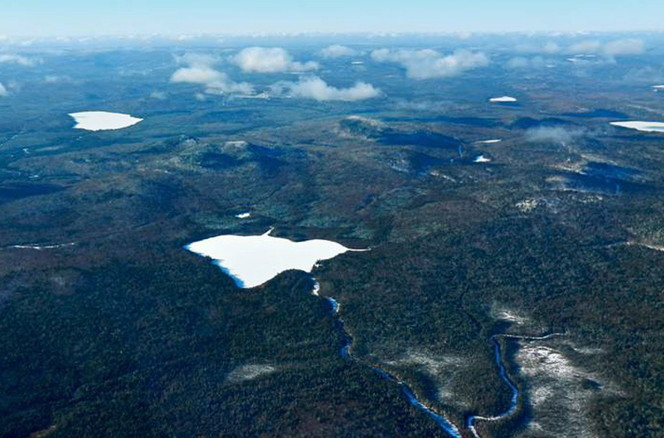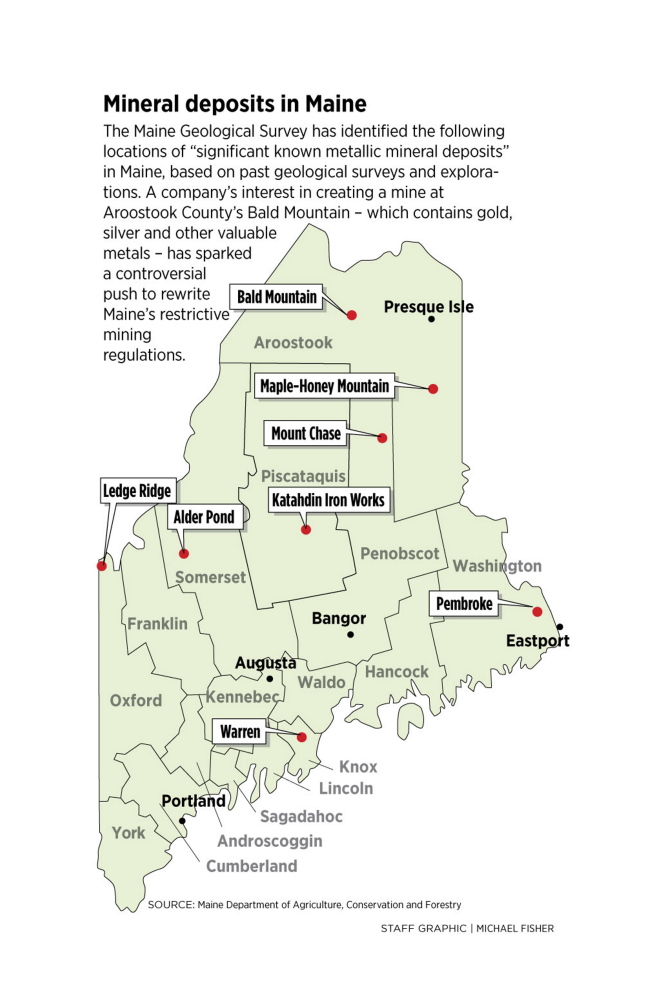An Aroostook County mountain laced with gold, silver and other metals potentially worth billions of dollars will again be the center of attention when the contentious debate over Maine’s stringent mining regulations begins anew in Augusta next week.
Aroostook’s Bald Mountain, however, isn’t the only location in Maine with valuable, potentially extractable minerals.
The Maine Geological Survey lists 10 sites of “significant known metallic mineral deposits” in the state, scattered from Warren in midcoast Maine to the state’s mountainous western border and Bald Mountain in the north. Dozens more known deposits have yet to be fully explored.
After a nine-month hiatus, lawmakers will receive a briefing Monday on metallic mining as they resume consideration of a proposed overhaul of quarter-century-old environmental regulations that guide mine locations and operations in Maine. And once again, environmental and conservation groups are gearing up to oppose rules they claim lack adequate safeguards for protecting fragile waterways, as well as taxpayers’ wallets in the event a mine operator goes bankrupt.
The debate will likely focus on Bald Mountain, a remote spot 35 miles west of Presque Isle where the Canadian corporate giant, J.D. Irving Ltd., wants to open a mine to remove minerals worth $6 billion to $7 billion, according to one 2008 estimate. Supporters contend the mine will bring hundreds of good-paying jobs to a part of Maine that is rich in natural resources but poor in economic opportunities, while protecting the region’s natural beauty.
“If we are going to survive up here in northern Maine, we are going to have to utilize our natural resources,” said Rep. John Martin, an Eagle Lake Democrat and supporter of revising Maine’s mining rules. “We can’t rely on someone coming in and starting a factory of some sort.”
Opponents fear the less-restrictive rules could open the floodgates to mining operations, and potential pollution, around the state.
“The rules would apply statewide and I think it is important for the Legislature to remember that,” said Nick Bennett, senior scientist with the Natural Resources Council of Maine. “Irving has definitely been behind this. And if they get what they want – which is weaker regulations – it will put a lot of other sites around the state at risk.”
MINING EFFECTIVELY IMPOSSIBLE
Long known for the bounty of natural resources found in its waters and woods, Maine also sits on valuable ground from a geological standpoint. Landmark structures such as the Brooklyn Bridge were built with Maine granite, and the state also is known for producing world-class tourmaline and other gems. Several sites around the state – such as the Blue Hill Peninsula town of Brooksville – have hosted copper and zinc mines going back more than a century.
Geologists have known for decades that significant quantities of gold, silver, copper and zinc lie beneath Bald Mountain. But none of the several attempts to begin extracting the minerals at Bald Mountain have come to fruition.
In early 2012, New Brunswick-based J.D. Irving Ltd., which owns vast swaths of timberland as the state’s largest landowner, worked with supportive lawmakers to introduce legislation to rewrite the state’s mining regulations. Adopted in 1991, those regulations have all but shut down commercial mining for minerals in Maine.
The Legislature passed a bill in 2012 directing the Maine Department of Environmental Protection and the Board of Environmental Protection to craft new rules for metallic mining. But environmental groups, as well as some outdoor recreation organizations, opposed the proposed rules put forward by the DEP, leading to a legislative standoff last year.
The Democratic-controlled Legislature refused to endorse the proposal – as required under what’s known as “major substantive rules” – and instead directed the DEP to return with a new proposal by 2016. However, Gov. Paul LePage vetoed the bill, so the old rules remain in effect.
The DEP is expected to resubmit the same proposed rules to the Legislature’s Committee on the Environment and Natural Resources for review. Additionally, committee member Martin, and the Senate co-chairman, Sen. Tom Saviello, R-Wilton, have introduced legislation to revise the rules. Both men said last week that their bills – which have yet to be printed – were essentially place-holders in case statutory changes are needed after reviewing the DEP rule proposals.
Saviello noted that while the committee features several new faces, there is also a slate of veteran lawmakers already well-versed in the mining issues. Saviello hopes the committee will be able to resolve the thorniest issues this year to allow additional mining – whether at Bald Mountain or elsewhere – while protecting Maine’s environment and taxpayers.
“I want to have a fair solution,” Saviello said.
WATER QUALITY AN ISSUE
“It’s almost like Groundhog Day,” said Jeff Reardon with Trout Unlimited, a vocal opponent of the DEP’s proposed mining rules. “The legislative context is a little different, but we essentially have the same arguments on the same issues over and over again.”
Opponents like Trout Unlimited, the Natural Resources Council of Maine and Maine Audubon argue that the DEP’s rules would allow mining operations too close to water bodies and do not require adequate indemnity – or insurance coverage – from mine operators. They also want to require mining companies to leave behind a clean site with no residual polluted wastewater or groundwater after operations cease. The DEP’s proposal, critics argue, would allow mine operators to run a wastewater treatment facility in perpetuity.
“And that’s a bad thing for Maine taxpayers because wastewater treatment plants fail over time, and mining companies have a tendency to cut and run,” the NRCM’s Bennett said.
Irving spokeswoman Mary Keith said in a statement that the company will follow the debate in the Legislature closely.
“We look forward to participating in the upcoming public meetings,” Keith said. “Our commitment is to responsible operations in the state and we believe that responsible mining can provide for vital job creation in northern Maine.”
It is unclear how the mining debate will play out in the new Legislature, where Republicans and Democrats each control one chamber. Last year’s bill ordering the DEP to start the rule-making process again – thereby rejecting the department’s proposed rules – passed the House on an 87-56 vote that fell largely along party lines. But after breezing through the Senate, supporters failed to muster enough support to override LePage’s subsequent veto.
Martin, a former longtime speaker of the House known for his parliamentary acumen, was not serving in the Legislature last year, but said he would not have supported the DEP’s proposed rules because they did not do enough to allay opponents’ fears about water-quality contamination and long-term site remediation. But Martin is optimistic a compromise is possible.
“I feel confident that we can do this,” he said.
HOPE TEMPERED BY SKEPTICISM
Aroostook County native Shelly Mountain will be among those keeping a close watch.
Although not one of Martin’s constituents, Mountain and her family own a camp on Portage Lake, which is within Martin’s district and is located roughly 15 miles from Bald Mountain. She is skeptical of the projections of hundreds of jobs and worries that acidic runoff or arsenic pollution from the mine will pollute the lakes and rivers that support the local tourism economy.
Mountain said people in the area have always regarded Bald Mountain as having the potential to “save the economy” in the struggling region.
“So when they first brought this up, I was excited,” Mountain said. “But then I started to go to the forums that were organized by the mining interests, and I was not convinced that they can protect the environment … and what we have there now.”
Copy the Story LinkSend questions/comments to the editors.






Success. Please wait for the page to reload. If the page does not reload within 5 seconds, please refresh the page.
Enter your email and password to access comments.
Hi, to comment on stories you must . This profile is in addition to your subscription and website login.
Already have a commenting profile? .
Invalid username/password.
Please check your email to confirm and complete your registration.
Only subscribers are eligible to post comments. Please subscribe or login first for digital access. Here’s why.
Use the form below to reset your password. When you've submitted your account email, we will send an email with a reset code.